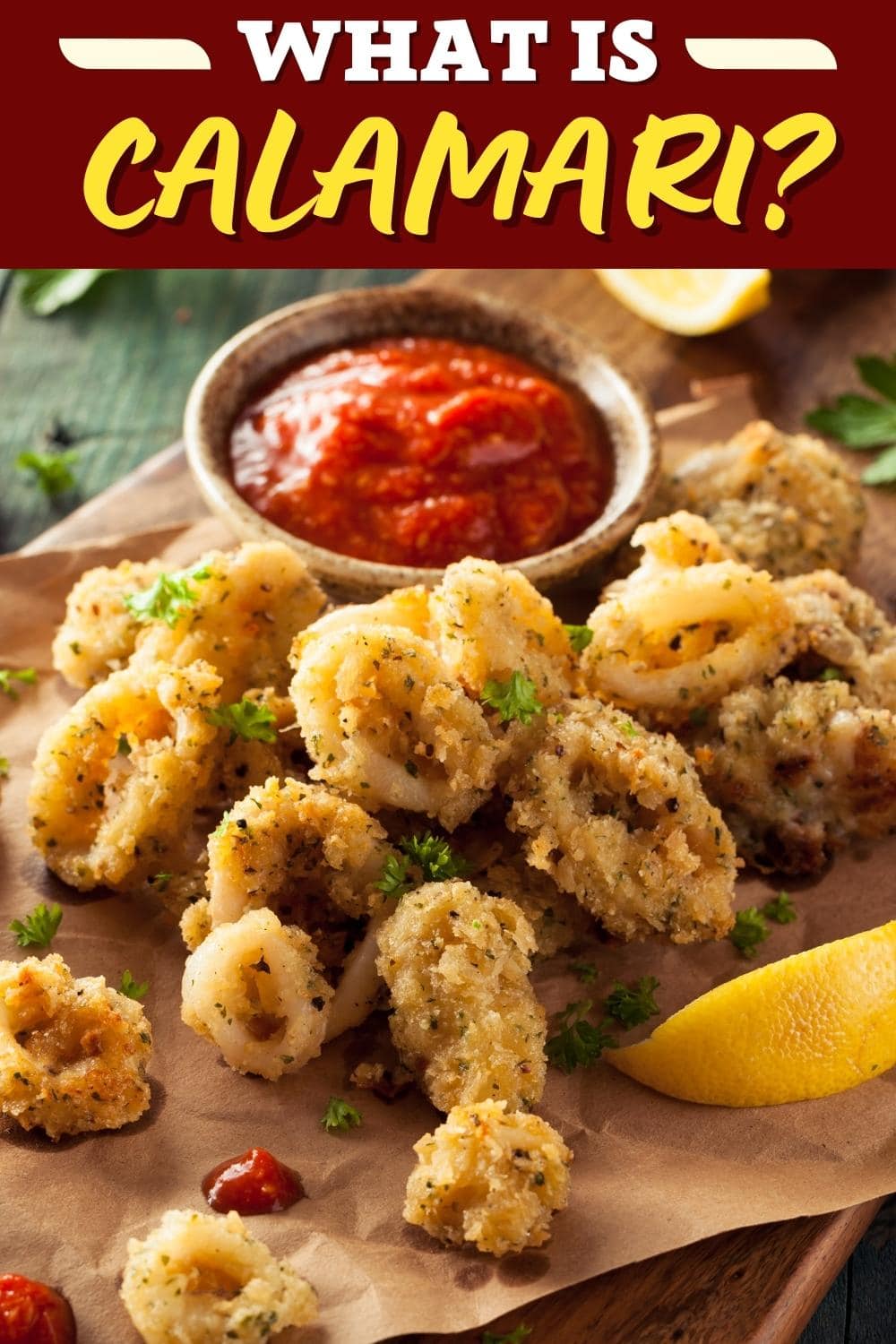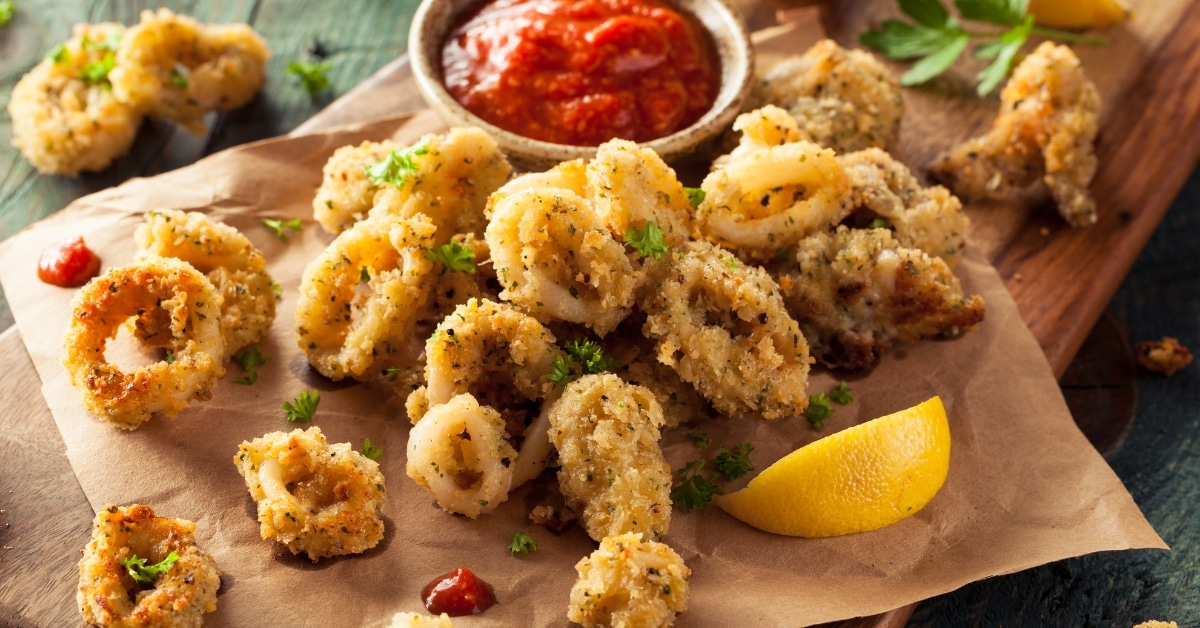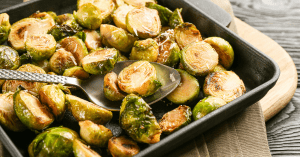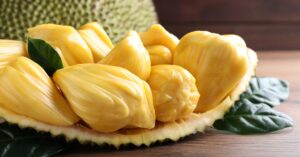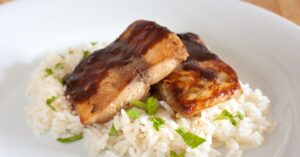If you found your way here, you’re probably wondering, what is calamari?
Well, it’s a dish that has been delighting dinner guests and tantalizing tastebuds for centuries.
Literally translated, calamari is an Italian word that simply means squid.
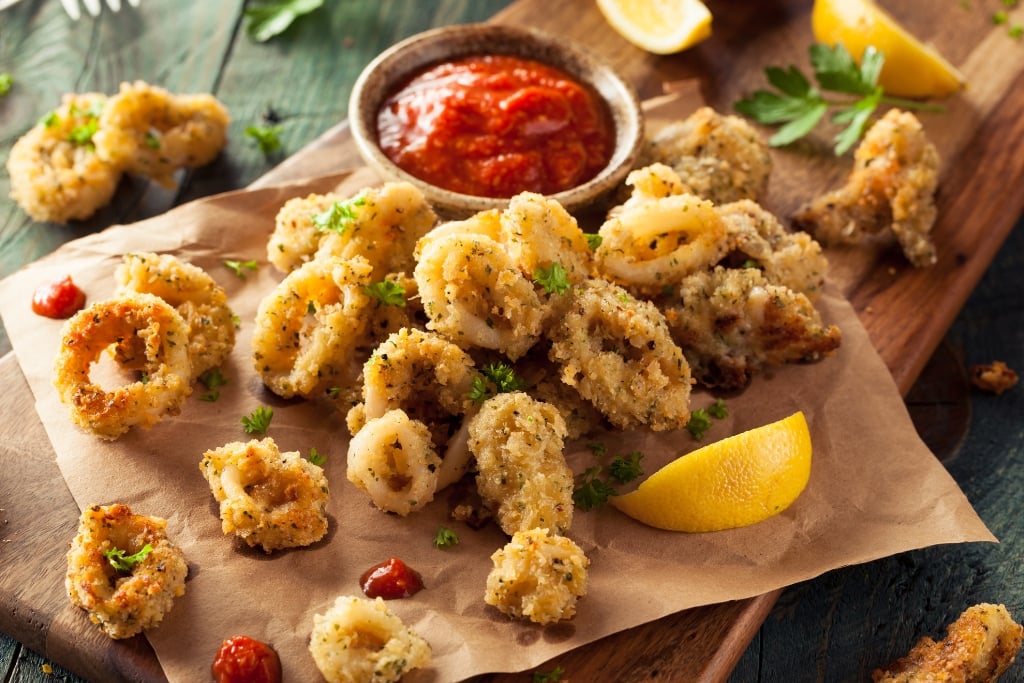
And at its core, that’s exactly what calamari is.
However, in America, people mostly use the word calamari to describe cooked squid.
In this article, I’ll tell you all about the specific prep and cooking methods for calamari.
I’ll also discuss how it tastes, where it comes from, and how to clean and store it.
Keep reading for more info!
What Is Calamari?
As I’ve already mentioned, calamari is the Italian word for squid.
Of course, you won’t see many people staring into tanks at the aquarium saying, “Look at that calamari!”
Instead, Americans, and people in other parts of the world, use the term in cooking.
Specifically, calamari is cooked squid.
Typically, people batter and deep-fry their calamari.
In many restaurants, it’s indistinguishable from onion rings until you bite into it.
That’s not the only way to cook it, though. We’ll talk a bit more about that in a later section.
Suffice it to say, there are plenty of non-fried calamari recipes.
Some of them even include eating the meat raw!
Now, let’s talk a bit about where calamari comes from and how it tastes.
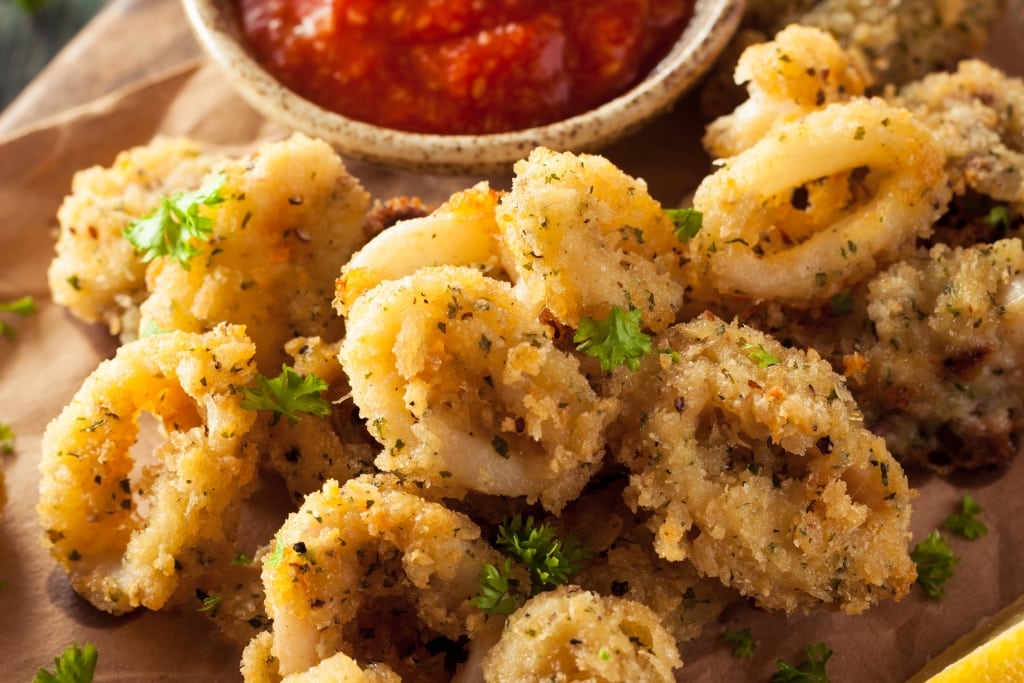
Where Does Calamari Come From?
Like most things we consider “seafood,” calamari comes from, you guessed it, the sea!
Specifically, you can find squid in every body of saltwater on earth, save the Black Sea.
In the United States, much of our calamari comes from Monterey Bay, Cape Cod, and off the coast of Rhode Island.
However, more than half the world’s calamari supply comes from Japan.
Different species of squid are more populous in different areas. For example, the Atlantic squid comes from the Atlantic Ocean.
The Humboldt squid, on the other hand, hails from the Pacific.
Some of Japan’s most common squid exports come from the Pacific Ocean. Those species include the following:
- Japanese flying squid
- Firefly squid
- Sword-tip squid
In short, you can probably find squid if you visit an ocean or sea (besides the Black Sea).
What Does Calamari Taste Like?
Calamari is seafood for people who don’t really like seafood.
The meat has an understated and mild flavor.
Some people describe it as lightly sweet and nutty. It isn’t fishy like a lot of seafood.
Other people even claim they find it almost bland.
Like mushrooms, it does great with seasonings and sauces, though. It easily and naturally takes on their flavors.
Often, you’ll receive calamari with various bold-flavored dipping sauces for extra flavor.
Marinara, garlic-lemon mayo, and creamy chipotle sauce are three popular options. Garlic aioli is another.
The way you cook calamari will also influence its taste.
For example, battered and fried calamari will taste different from grilled calamari skewers.
As for texture, it’s a firm white meat that becomes quite tender when cooked correctly.
It’s also chewy but should never feel rubbery in your mouth. If it does, it’s likely overcooked.
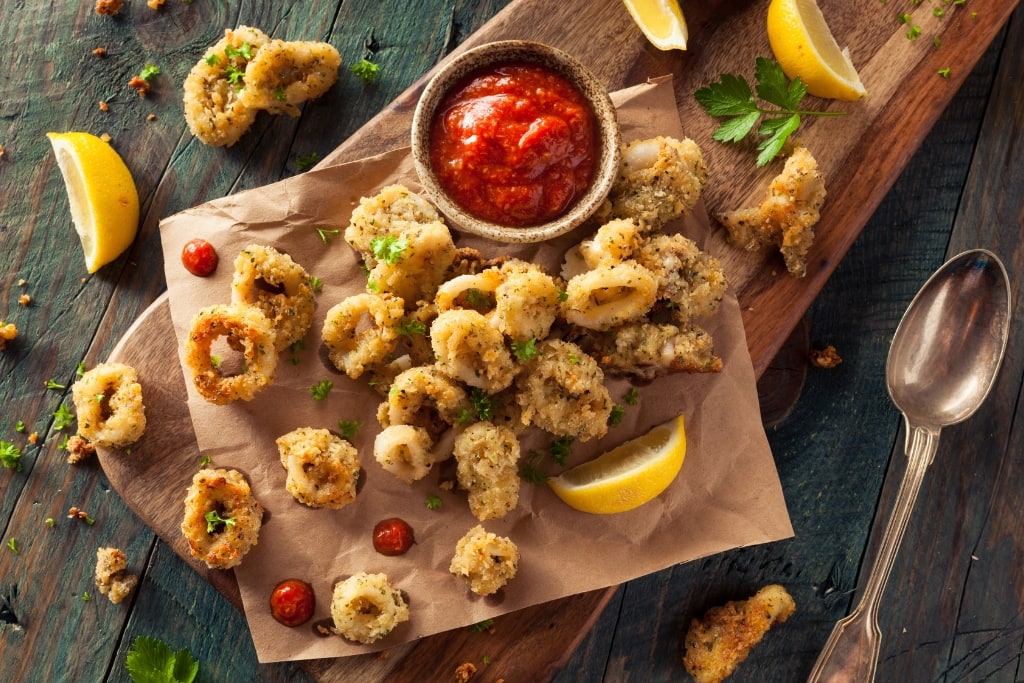
How to Cook Calamari
Though deep-fried calamari appetizers are common, that’s not the only way to cook the meat.
You can also boil or broil it, saute it, grill it, or eat it raw.
As for purchasing calamari, you can find it fresh pretty easily.
Many stores also sell it pickled, canned, frozen (or flash-frozen), and dried.
You can even find it pre-cooked and frozen. All you have to do is heat it.
It’s an extremely versatile type of seafood, but it isn’t always easy to cook.
When raw, calamari is thin and very tough.
You have to know how to cut it correctly.
It’s also easy to overcook if you don’t know what you’re doing. And cleaning it yourself can be a challenge.
Many recipes also require you to cook it before adding a marinade or seasonings.
Still, anyone can learn to prepare it. It just takes a little practice.
Here are ten of my all-time favorite recipes using fresh or frozen calamari:
- Salt and pepper air fryer calamari
- Pan-grilled calamari
- Absolutely delicious stuffed calamari
- Lemon caper calamari steaks
- Fresh calamari salad
- Fresh Sicilian marinated calamari salad
- Calamari with tomato sauce
- Simple grilled calamari
- Calamari fritti with pepper sauce
- Squid ink calamari
Pro tip: Soak calamari in buttermilk for half an hour before cooking it. Doing so makes it juicy, succulent, and tender.
Where to Buy Calamari
Buying fresh calamari is easiest if you live somewhere near the ocean, of course.
But what if you live in a landlocked state like Utah or Kentucky? Are you just out of luck?
Actually, no!
Even if you don’t have any nearby seafood markets, you can still buy calamari.
Most large-scale grocery stores regularly keep both fresh and frozen varieties in stock.
As I mentioned, Japan exports a ton of calamari all over the world.
However, you can often find calamari that comes from closer to home.
If you have a local Asian market in your area, that’s another great place to check.
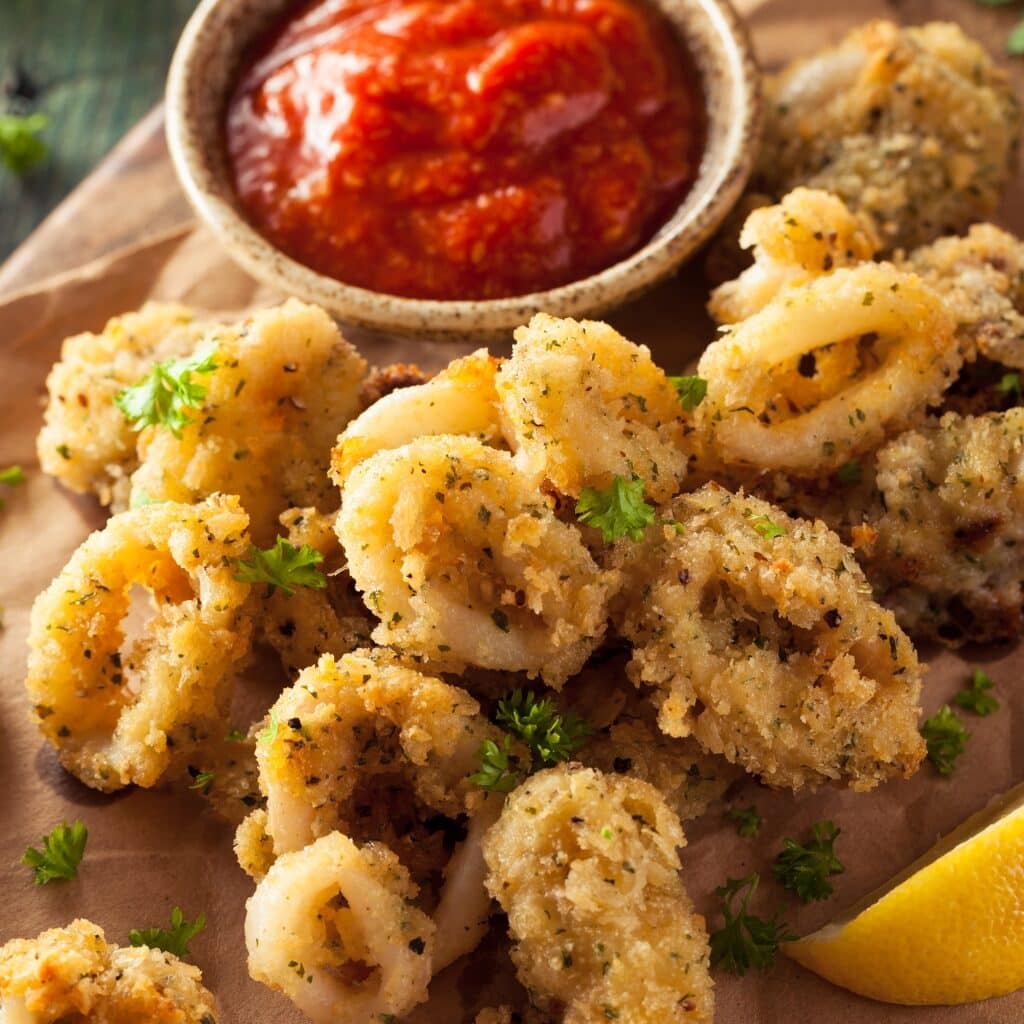
How to Store Calamari
Once you find your calamari, the next step is figuring out how to store it.
Unless you’re cooking with it immediately, of course. Most people, though, need to store it for at least a few hours first.
If you purchased frozen calamari, storage is simple.
Just pop it back into the freezer in the same container you purchased it in. Storing fresh calamari takes a little more effort, though.
You can store it in the fridge for only a few (maybe 3) days.
However, most chefs recommend eating it right away or freezing it.
Either way, you should clean it first. This entails removing the head, internal organs, ink sac, and body tube.
Then, you’ll need to cut off the tentacles and remove and discard the beak.
Don’t discard the tentacles! Those are edible and really delicious.
Next, you’ll need to remove the cuttlebone and skin the squid. (Skinning is optional, as the skin is edible.)
Once you’ve done all that, it’s time to store your squid meat.
For refrigerator storage, wrap it in plastic wrap and slide it into a Ziploc bag.
Then, remove as much air from the bag as possible.
Again, I want to reiterate that storing squid this way will preserve it for a maximum of 3 days.
It may also lose some of its quality and freshness even in that small amount of time.
It’s better to cook it the same day you purchase it, within 6 hours if possible. Your alternative is to freeze it.
To do that, place the squid in plastic freezer bags.
Remove as much air as possible from the bags. Then, you can freeze them for up to 2 months.
You’ll store and freeze your cooked squid following the same instructions.
It’ll last about the same amount of time (3 days in the fridge, 2 months in the freezer).
You can cook frozen calamari directly from frozen or let it thaw overnight in the fridge.
You can also submerge the sealed bags in warm water to help the calamari thaw faster.
And finally, remember: never refreeze thawed calamari.
In fact, that’s a good rule of thumb for any frozen and then thawed meat.
